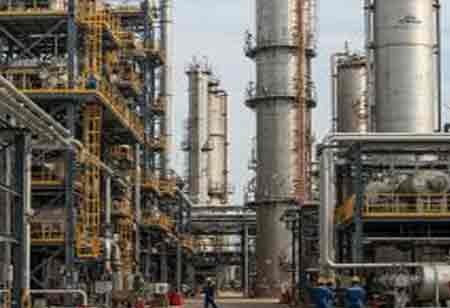Thank you for Subscribing to Energy Business Review Weekly Brief
Oilfield Chemical Manufacturing: Balancing Efficiency and Environmental Compliance
Oilfield chemical manufacturing is pivotal in the oil and gas, enhancing production, efficiency, and environmental compliance.

By
Energy Business Review | Thursday, May 01, 2025
Stay ahead of the industry with exclusive feature stories on the top companies, expert insights and the latest news delivered straight to your inbox. Subscribe today.
Oilfield chemical manufacturing is pivotal in the oil and gas, enhancing production, efficiency, and environmental compliance. As the industry navigates a rapidly changing landscape, understanding the factors shaping this sector, such as emerging trends, challenges, and opportunities, becomes essential for stakeholders. The global demand for oil and gas is a primary driver of oilfield chemical production. Fluctuations in crude oil prices significantly affect drilling and extraction activities, directly influencing the chemical requirements of these operations.
Technological advancements are crucial in developing more efficient and environmentally friendly chemicals tailored to meet the evolving needs of the industry. In addition, regulatory policies impose stringent environmental and safety standards, pushing manufacturers toward sustainable solutions. The availability of essential raw materials, such as surfactants, corrosion inhibitors, and demulsifiers, also impacts production capabilities.
Geopolitical factors, like trade restrictions and international conflicts, further complicate supply chain logistics, resulting in price volatility and production challenges. With an increased focus on sustainability, companies invest in biodegradable chemicals and eco-friendly solutions that minimize environmental impact. The interplay of these factors shapes the trajectory of oilfield chemical manufacturing, influencing the industry's competitiveness and evolution.
Emerging Trends in Oilfield Chemistry
The industry is undergoing several transformative trends focusing on enhancing sustainability and efficiency. One notable trend is adopting green chemistry principles, which promote the development of biodegradable and non-toxic alternatives to traditional oilfield chemicals. This shift is spurred by an industry-wide commitment to reducing carbon footprints and enhancing operational standards. Digitalization and automation are revolutionizing oilfield chemical manufacturing. Artificial intelligence (AI) and machine learning (ML) facilitate the optimization of chemical formulations and their applications, leading to enhanced operational efficiency.
Furthermore, advancements in nanotechnology are yielding more effective corrosion inhibitors, demulsifiers, and scale inhibitors that significantly improve oil recovery rates. Innovative chemicals endowed with real-time monitoring capabilities are also emerging in the industry. Such chemicals can adjust their properties in response to changing environmental conditions, optimizing their effectiveness. For instance, self-healing pipeline coatings demonstrate the potential to repair minor damages autonomously, ultimately reducing maintenance costs and operational downtime.
Diverse Applications and Benefits
Oilfield chemicals serve a variety of applications throughout the oil and gas production process. Drilling fluids, comprising water- and oil-based muds, are essential for stabilizing wellbores and preventing formation damage during drilling operations. Corrosion inhibitors are crucial for protecting pipelines, equipment, and storage tanks from degradation, thus extending their operational lifespan and preventing costly repairs. Demulsifiers are vital in separating oil and water, facilitating efficient crude oil processing. Scale inhibitors mitigate mineral buildup within pipelines and wells, thereby maintaining flow efficiency and reducing the risk of operational disruptions.
In hydraulic fracturing, specialized chemicals such as friction reducers and proppants enhance fluid flow and maintain reservoir permeability, ensuring the effective extraction of resources. Fluid loss control additives are essential for minimizing water loss in formations, leading to reduced operational costs. Gas treatment chemicals are involved in refining and purifying extracted hydrocarbons, ensuring compliance with rigorous industry standards. Moreover, water treatment chemicals are crucial for managing wastewater, improving water recycling processes, and contributing to broader environmental sustainability efforts.
Challenges and the Path Forward
While the prospects for oilfield chemical manufacturing are promising, the industry faces numerous challenges. Stringent environmental regulations necessitate the development of safer, more sustainable chemical formulations, which invariably increases research and development costs. Additionally, the volatility of crude oil prices creates demand uncertainties for oilfield chemicals, raising concerns about market stability.
Supply chain disruptions remain a significant challenge, particularly concerning the sourcing of raw materials that can create bottlenecks in production and lead to cost fluctuations. Compatibility issues between new and existing chemical formulations also present technical hurdles that slow the adoption of innovative solutions within the industry. Looking to the future, the direction of oilfield chemical manufacturing lies in innovation, sustainability, and digital transformation. Increased research into biodegradable and environmentally friendly chemicals will drive market growth that is aligned with global sustainability goals.
Integrating blockchain technology can improve supply chain transparency, ensuring quality control and regulatory compliance while fostering trust among industry stakeholders. As renewable energy integration becomes more prevalent in manufacturing, companies will reduce carbon footprints and shift towards more sustainable operations. Collaborative efforts among industry players, research institutions, and regulatory bodies will further accelerate progress, fostering a resilient and adaptive sector committed to meeting production and environmental standards.
The future of oilfield chemical manufacturing is bright, marked by a concerted effort to innovate while prioritizing sustainability. Embracing automation and robotics in chemical blending and distribution can enhance precision, minimize human error, and elevate safety standards. As the industry leverages emerging trends and technologies, it will continue to evolve, adapting to challenges and enabling more efficient and environmentally friendly oil and gas production.






